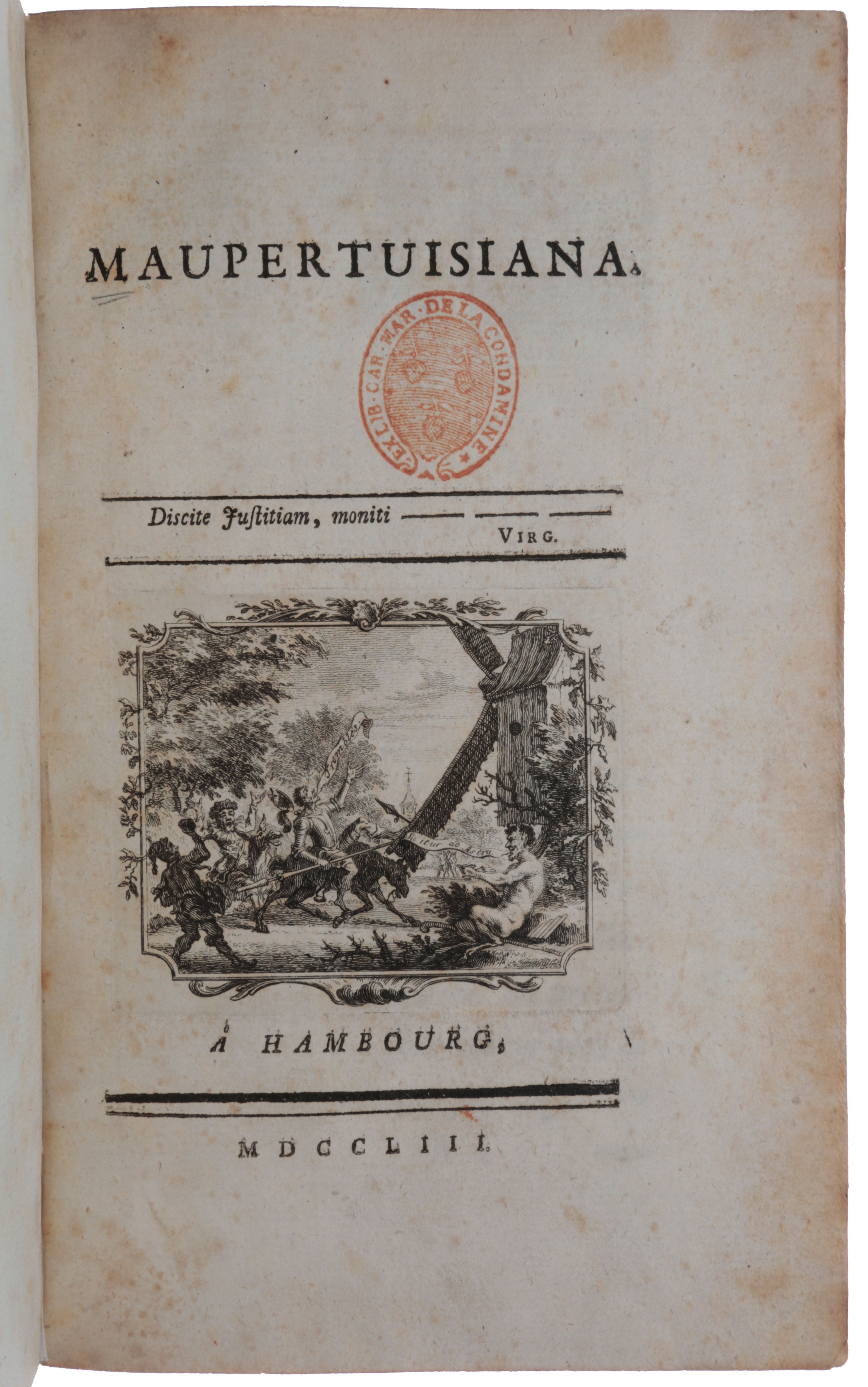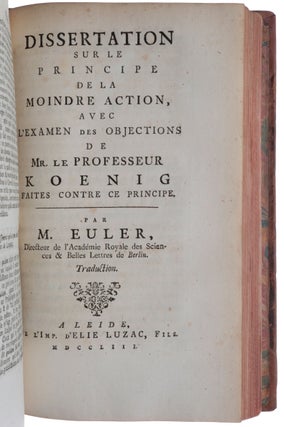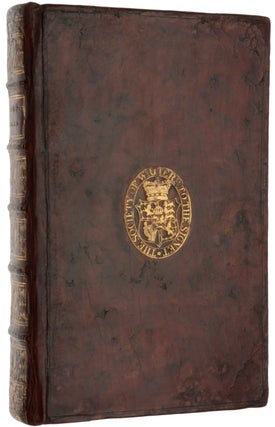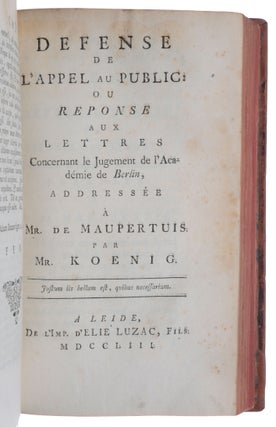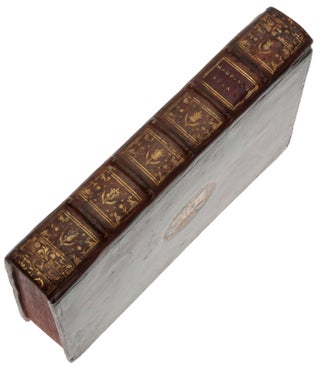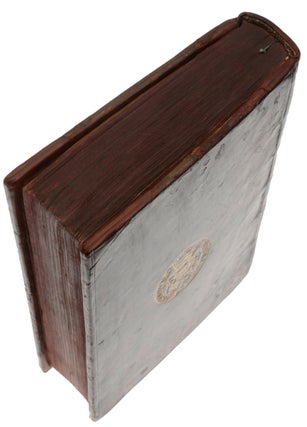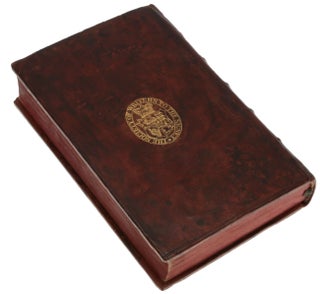Maupertuisiana.
Hambourg [i.e., Leiden]: [Élie Luzac], 1753. First edition, rare, of this collection of pamphlets relating to the ‘König affair,’ the celebrated polemic on the principle of least action, “perhaps the ugliest of all the famous scientific disputes” (DSB VII: 442). This is an exceptional association copy, from the library of Charles-Marie de la Condamine, Maupertuis’ closest friend and scientific colleague; they were jointly responsible for the famous expeditions to determine the length of an arc of the meridian near the poles (Maupertuis) and the equator (La Condamine), the aim being to decide once and for all whether the earth was an oblate or prolate spheroid – whether Isaac Newton or Jacques Cassini had been correct. “La Condamine, three years younger than Maupertuis, one of Maupertuis’s closest friends and a participant in the Newtonian campaign, headed the Academy’s expedition to Peru of 1735-44” (Greenberg, p. 113). The König affair is of considerable importance in the history of physics, since the principle of least action “was clarified and underwent important developments at the hands of [William Rowan] Hamilton and [Carl Gustav Jacob] Jacobi in the 19th century … [It] has come to play a fundamentally important part in twentieth-century Physics” (Wolf, p. 69). Although initially a quarrel between Pierre-Louis Moreau de Maupertuis (1698-1759) and Johann Samuel König (1712-57), the dispute drew in, among others, Leonhard Euler (1707-83), Voltaire (1694-1778) and the ‘philosopher King’ Frederick II of Prussia (1712-86). Beginning as a narrow scientific priority dispute, it became a battleground of love and jealousy, patronage, academic freedom and the control of knowledge and of print. The collection comprises: Provenance: Charles-Marie de la Condamine (1701-74) (ink stamp on title); The Society of Writers to Her Majesty’s Signet (gilt stamp on both covers of the binding). The origins of the principle of least action lie in antiquity, when Hero of Alexandria (fl. c. 62 AD) showed that the path taken by light reflected from a mirror is that of shortest time; this was extended by Pierre de Fermat (1601-65) in the 17th century to the case of refraction. But the modern form of the principle is ascribed to Maupertuis who in 1744 published in Histoire de l’Académie Royale des Sciences (Paris) his paper ‘Accord de différentes loix de la nature qui avoient jusqu’ici paru incompatibles,‘ in which he put forward his rather vague “principle by which nature, when realizing its actions, always goes along the simplest path.” Two years later, he published in Histoire de l'Académie Royale des Sciences et des Belles-Lettres de Berlin his ‘Les loix du mouvement et du repos déduites d’un principe metaphysique,’ in which he stated “A general principle: When a change occurs in nature, the quantity of action necessary for this change is least possible. The quantity of action is the product of the masses of the bodies by their speeds and by the distance over which they move.” This principle had, in fact, been stated for the case of an isolated body by Euler in Additamentum II of his Methodus inveniendi lineas curvas (1744), although Euler did not raise any questions of priority. Maupertuis was very proud of his principle – he believed not only that he had reduced all of mechanics to a single rule, but claimed to have derived from it a metaphysical demonstration of the existence of God. In the spring of 1751 König published in Nova Acta eruditorum ‘De universali principio aequilibrii et motus,’ in which he denied the universality of Maupertuis’ principle of least action and claimed to have a letter sent by Gottfried Wilhelm Leibniz (1646-1716) in 1707 to Jakob Hermann (1678-1733) in which Leibniz writes “I remarked that in modifications of movements [action] becomes ordinarily a Maximum, or a Minimum.” Maupertuis saw in this both an accusation of plagiarism and a challenge to his honour, and demanded that König produce the original of the letter. When neither König nor anyone else succeeded in producing the letter, Maupertuis, as president, called the Academy into plenary session on 13 April 1752 to hear a charge of forgery against König, with Euler putting the case for the Academy (Maupertuis himself was not present). König claimed that his copy of Leibniz’s letter had been made from an original owned by Henzi, a Bern collector of manuscripts, but this could not be verified as Henzi had been put to death by his political opponents and all his papers had been burned. The Academy found König guilty of forgery. In response, he published a pamphlet Appel au public in which he quoted in full the copies of four letters in his possession which he himself had copied from original letters of Leibniz owned by Henzi (this was first printed in the Nova Acta Eruditorum for 1751). He made a convincing case, but neither Maupertuis nor Frederick II were prepared to listen. König had no option but to resign from the Academy. The decision of the Academy triggered an international debate about the conduct of the Academy and its president, and Voltaire played a key role in fuelling the dispute. On 18 September 1752 an anonymous pamphlet Response de l’Academicien de Paris à l’Académicien de Berlin defending König appeared; we now know that it was written by Voltaire. But his most effective work was the satirical Diatribe du Docteur Akakia, médecin du Pape in which the fictional doctor is ostensibly warning the president (Maupertuis) that a young man is trying to pass off his own, inferior works as the president’s. Akakia quotes outlandish statements made by the young man, all of which are in fact drawn from Maupertuis’ works. So he tells us the young man had ‘claimed that children are formed in the mother’s womb by attraction, that the left eye attracts the right leg, etc.’ Maupertuis had argued that a foetus is formed from mixing ‘parts’ from the two parents, where each part is attracted towards parts corresponding to those that had been close to it before. This is speculation based on thin evidence but was hardly as naïve as Akakia suggests. Frederick II could not stand by as the president of his own Academy came under attack. The original edition of Akakia, printed at Potsdam, was officially condemned in Prussia and all copies were burned by the public executioner on Christmas Eve 1752 in the presence of both the King and Voltaire. Voltaire succeeded in having it reprinted throughout Europe (this second edition appears in the present collection, as in all copies of Maupertuisiana), but Voltaire soon left Berlin. Although Voltaire’s participation in the dispute is often explained as a reaction to what he perceived as Maupertuis’ abuse of power, its origins lie elsewhere. Voltaire had arrived at Berlin in July 1750, not long after the death of his protégé and lover the Marquise du Châtelet. He and Maupertuis were old friends. Maupertuis had advised him on his Philosophical Letters (1735) and had even made a few visits to Cirey where he found a vigorous admirer in the Marquise, perhaps stirring feelings of jealousy in Voltaire. König had also visited Cirey and had turned Mme. du Châtelet into a disciple of Leibniz, much to Voltaire’s disgust. Once in Berlin, Voltaire found it difficult to share the intellectual spotlight with Maupertuis. Their friendship came to an end when Maupertuis refused to use his influence to support Voltaire when he became involved in a lawsuit over certain financial speculations. The König affair was Voltaire’s chance to even the score, even if it meant forgetting his earlier animosity toward König.
8vo (205 x 128 mm), 15 parts bound in one volume, large engraved vignette to title page of first part, engraved head- and tail-pieces and initials (occasional light foxing and browning). Contemporary polished calf, spine gilt with red lettering-piece, gilt stamp of Society of Writers to the Signet on both covers, marbled endpapers (carefully restored).
Item #5306
Price: $9,500.00

